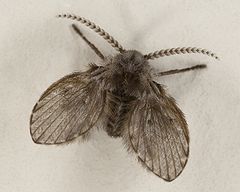Psychodidae
This article includes a list of general references, but it lacks sufficient corresponding inline citations. (March 2015) |
| Drain fly | |
|---|---|

| |
| Clogmia albipunctata | |
| Scientific classification | |
| Kingdom: | |
| Phylum: | |
| Class: | |
| Order: | |
| Suborder: | |
| Infraorder: | |
| Superfamily: | |
| Family: | |
| Subfamily: | |
| Tribe: | |
| Genus: | |
| Species: | C. albipunctata
|
| Binomial name | |
| Clogmia albipunctata Williston, 1893
| |
| Synonyms | |
| |
The drain fly are small true flies (Diptera) with short, hairy bodies and wings giving them a "furry" moth-like appearance.
Description
Drain flies are classified as nematocera and are small (<2 mm). The adults have long antennae and the wings are leaf-shaped, either slender or broad, with the most elementary wing venation of any Diptera, having little more than a series of parallel veins without crossveins. Adult Psychodidae are typically nocturnal though they orient themselves around lights and may appear to be attracted to light.
As a nuisance, they are associated with damp habitats in human bathrooms and kitchens. The larvae of the subfamilies Psychodinae, Sycoracinae and Horaiellinae live in aquatic to semi-terrestrial or sludge-based habitats, including bathroom sinks, where they feed on bacteria and can become problematic.[1] Prevention is best accomplished by removing food sources such as hair clogs in drains.
The adults live for about 20 days, during which they will breed only once. Adults lay their eggs just above the water line inside moist drains. Sometime later, these eggs hatch into drain worms. The dark 6–7 mm long larvae are similar to those of mosquitoes in that they breathe through a small tube located at the back end of their narrow, maggot-like bodies. These larvae can sometimes be seen crawling along the moist edges of crevices in shower stalls or bathtubs. The insects complete their pupation stage submerged/ wet, and the adults then hatch at or under the waterline.[citation needed]
Pest control
Because of the extremely fine water-repellent hairs covering their bodies, adult drain flies are virtually impossible to drown, and are not affected by contact with most water-borne toxins such as bleach. Boiling water has little or no effect on the adults for the same reason, and even the eggs are highly resistant to both chemical or thermal assault. Eggs can also withstand periods of dehydration. Extermination of this household pest depends of the maintenance of clean household drains for a period of at least three weeks.[citation needed]
Because of their attraction to light, drain flies may sometimes be controlled by using fan-based traps baited with visible or ultraviolet light.[citation needed]
References
- ^ Denny Schrock (31 January 2004). Ortho home gardener's problem solver. Meredith Books. ISBN 978-0-89721-504-6. Retrieved 1 August 2011.

